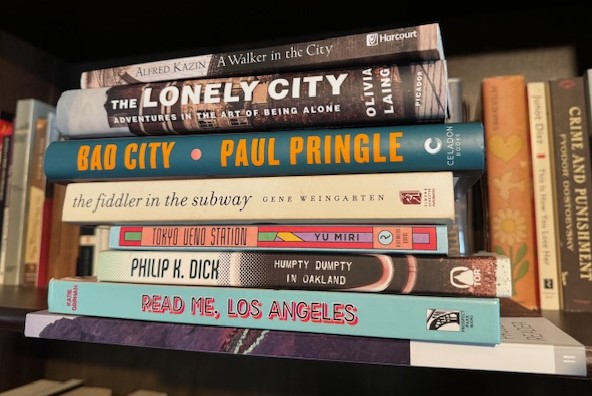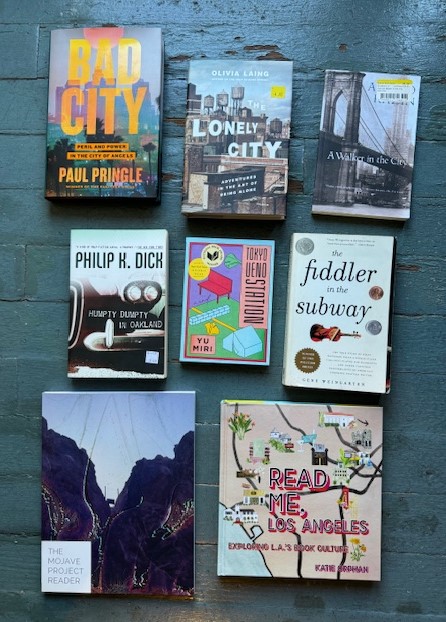Books acquired: “Palm Springs Legends: Creation of a Desert Oasis,” Greg Niemann; “A Battle of Love and Glory,” Reyna Grande; “Anatomy of 55 More Songs,” Marc Myers
Books read: “Bad City: Peril and Power in the City of Angels,” Paul Pringle; “The Lonely City: Adventures in the Art of Being Alone,” Olivia Laing; “A Walker in the City,” Alfred Kazin; “Tokyo Ueno Station,” Yu Miri; “The Fiddler in the Subway,” Gene Weingarten: “Read Me, Los Angeles: Exploring L.A.’s Book Culture,” Katie Orphan; “Humpty Dumpty in Oakland,” Philip K. Dick
Happy December! I had a big November, books-wise (which is the entire point of these posts), with eight (!) books read. I listened to two as audiobooks, one was short, two were read from my nightstand and the final one was finished Dec. 5, which maybe was cheating a bit. But it fit the loose theme, which was fiction or nonfiction with titles that either included the word “city” or seemed to involve cities.
“Bad City” (2022): A story about scandals at an elite institution in LA, the nitty-gritty of how those scandals were unraveled by reporters and the bureaucratic logjams at the newspaper that kept the story on ice for months. (The investigation eventually won a Pulitzer.) It’s also a window into the slow collapse of newspapers. Overall, it’s valuable. I do question the decision to summarize the scandal at the outset, making the process of uncovering of the details less exciting (since what’s news to the reporters is now old news to us). And there’s more than a whiff of revenge narrative behind the takedowns of various LA Times editors who served as roadblocks. Also, “Bad City”? What a strange, reductive title. (Birthday gift, 2023; listened to on audio.)
“Lonely City” (2016): I hadn’t expected these “Adventures in the Art of Being Alone” to consist largely of an exploration of a half-dozen outsider artists, half of whom I’d never heard of, but one of whom I love (Hopper), and most of whom were connected to NYC. Still, the profiles of and meditations on the artists held my interest due to Laing’s deep-dive research, lucid writing, passion and empathy. (Bought in 2021 at Milwaukee’s Downtown Books; listened to on audio.)
“A Walker in the City” (1951): Very evocative of a certain time and place, the late ’20s and early ’30s in the Jewish tenements of Brownsville, a far eastern outpost of Brooklyn that to young Kazin didn’t even seem to be part of NYC. Vivid, sometimes florid remembrances of sights, smells and activities: candy shops, street games, books, Socialist meetings, hot nights on fire escapes. Lyrical, but not quite compelling. (Also, I expected more walking.) (Bought in 2015 at New York City’s Strand Books, which seemed appropriate.)
“Tokyo Uno Station” (2021): A man’s bad luck leads to homelessness, a condition that continues after his death. Spare and observant, sometimes lovely, but it didn’t grab me. NPR called this “a harsh, uncompromising look at existential despair,” which it turns out is not really my thing. (Bought in 2021 at St. Louis’ Subterranean Books.)
“The Fiddler in the Subway” (2010): Journalist Weingarten’s persona online can be aggressive and juvenile, but here, thankfully, that’s seen only in some of the introductions. These essays and feature stories, two of which won Pulitzers, are insightful, surprising, observant and sometimes devastating, whether the topic is a reunion with an elementary school crush, a chat with a non-voter, a visit to a remote Alaskan town, a search for the “armpit of America” or a sympathetic portrait of parents who accidentally forget their children in the backseat. (Bought in 2016 at St. Louis’ Patten Books.)
“Mojave Project Reader, Vol. 2” (2021): This is the second of four (to date) intelligent, well-designed compendiums about desert topics, taken from an ongoing online journal. In this case, topics include desert tortoises, the folk-art Amargosa Opera House, the town of Needles (clever title: “Needles and the Damage Done”), Joshua Tree musicians, the former mining camp of Darwin, the story of Borax and a mythical underground river of gold. (Bought in 2023 at Yucca Valley’s Acme 5 Lifestyle.)
“Read Me, Los Angeles” (2020): A breezy, diverse look at L.A. literary culture, via profiles of authors living and dead, lists of books (mysteries, fiction, nonfiction, crime, YA, etc.) set in the county, lists of bookstores, lists of must-read books in different categories, visits to places described in fiction, book quotes about L.A. and more. A good, attractive nightstand book. (Birthday gift, 2023.)
“Humpty Dumpty in Oakland” (1986): Fairly strong — in contrast to protagonist Al Miller, who is apathetic and passive. Dick manages to incorporate a lot of his classic themes, tropes and settings into this long-unpublished 1960 social-realist novel: the Bay Area, working-class losers, paranoia, a conspiracy that may or may not be real. Compared to “The Broken Bubble” (the last of these PKD novels I tried, and which was a bit sodden), this was interesting and had enough deadpan comedy to keep me engaged. (Bought in 2013 at Berkeley’s Moe’s Books.)
“Fiddler” was the best of the lot, worth reading if you like narrative nonfiction. “Read Me” would be fun for the literarily inclined of Southern California. The rest were good to so-so.
How was your penultimate month of 2023?
I don’t have high hopes for December, in part because I really wanted to include the “Oakland” book with these despite finishing it Dec. 5, after 10 days of reading. (It wasn’t a hard book, there were just a lot of interruptions.)
I’d had an idea for December, which was to read “The Black Book” by Orham Pamuk, “The Red and the Black” by Stendhal and “Free Fall in Crimson,” the 19th Travis McGee novel. Clever, eh?
But the first two are 500-plus pages, and I could tell from the first page of Pamuk’s book (which he’d signed for me after a Claremont talk) with its Turkish names that I didn’t have the patience for it. I read about 30 pages of Stendhal’s novel before concluding that I didn’t have the patience for it either. Both are books I’ve owned for a dozen or more years and at this point the main reason I had for reading either is that I owned them, not that I was particularly compelled to read them. (Note to Terri: I’m curious if you’ve read Stendhal!) In the near future I probably won’t own these any longer, which will take care of that. That’ll lighten my unread material by about 1,100 pages. (Brushes imaginary dust from his hands.)
So what will I read in December? I picked out and put back three different novels off a bookcase this morning (Dec. 7), after picking out a different one last night and putting it back this morning. There’s no telling if I’ll like the one I settled on or will choose again, but I doubt I’ll finish more than one or two in the remaining time. It’s a frazzling period of the year. Maybe after November, I’m “read out” for a bit.
Next month: I’m at a loss! But I’ll come up with something.


